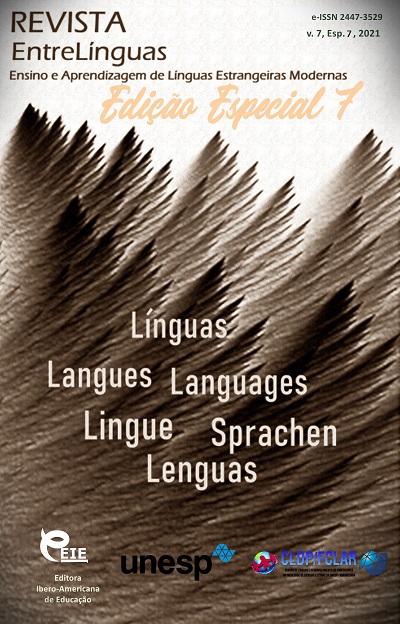Linguistic analysis of the political text: structure and functions of the election address
DOI:
https://doi.org/10.29051/el.v7iesp.7.16299Keywords:
Linguistics, Speech influence, Political text, Political communicationAbstract
The study investigates the language and genre structure and formation of a particular type of political text, an election address of a political leader to the electorate. The article considers the history of the appearance of the public speech genre in Russian political discourse, its functions, and linguistic features that solve the problem of revealing the main ideological content at the lexical level. The research material was the texts of Gennady Zyuganov’s election addresses in 2000 and 2019 taken from the Internet sources and the accompanying comments estimated to be about 50 sources. In the course of the study, the linguistic characteristics of the implementations of the political address functions (influence, inspiration, advocacy, and propaganda, informing), typical of this type of political statements, are revealed along with the established dynamics of changes in rhetoric by Gennady Zyuganov as the leader of a political party and its leading representative.
Downloads
References
Altunyan, A.G. (2006). Analiz politicheskih tekstov: uch. Posobie. – M.: Universitetskaya kniga; Logos, 384 s. (in Russian)
Bayley, P. (1985). Live oratory in the television age: The language of formal speeches // G. Ragazzini, D.R.B.P. Miller eds. Campaign language: Language, image, myth in the U.S. presidential elections 1984. – Bologna: Cooperativa Libraria Universitaria Editrice Bologna, 1985. P. 77-174.
Belyanin, V. P. (1996). Introduction to psychiatric literature.– Verlag Otto Sagner. Specimina Philologiae Slavicae. Band 107. – Munchen,. – 298 p.
Belyanin, V.P. (2009). Psycholinguistics. Textbook.– Moscow: Flinta: Moscow Psychological and Social Institute, – 416 p. (Student library/ Russian Academy of Sciences education, Mosc. Psych. and Soc. Inst.). – ISBN 5-89349-371-0 (Flinta) – ISBN 5-89502-421-1 (MPSI).
Garcia Santos, J.F. (1987). El lenguaje politico: En la Secunda Republica y en la Democracia. M. Alvar ed. El lenguaje politico. – Madrid: Fundacion Friedrich Ebert, Instituto de Cooperacion Iberoamericana, 1987. P. 89-122.
Ilikova, L. (2019). The five-star movement: From a blog to Italian government. Sovremennaya Evropa, 4, 129-140.
Morik, K. (1982). Uberzeugungssysteme der Kunstlichen Intelligenz: Validierung vor dem Hintergrund linguistischer Theorien uber implizite Ausserungen. Tubingen: Niemeyer, 269 p.
Tarasov, E.F. (1990). Speech impact: methodology and theory Text]. Optimization of speech influence [ed. by R. G. Kotov]. – Moscow: Nauka, 5-18.
Tushev, A., Bushkanets, L., Letyaev, V. (2019). Complex analysis of political speech. Journal of Sociology and Social Anthropology, 10(4),170-174.
Valgina, N.S. (2003). Theory of the text: textbook / Valgina N. S. – Publishing house: Logos, – 280 p.
Van Dijk Ten, A. (2013). Diskurs i vlast': Reprezentaciya dominirovaniya v yazyke i kommunikacii. — M.: Knizhnyj dom «LIBROKOM»,. — 344 s. (in Russian)
Wodak, R. (1997). Language. Discourse. Politics / Translated from English and German. – Volgograd: "Change", – 139 p.
Downloads
Published
How to Cite
Issue
Section
License

This work is licensed under a Creative Commons Attribution-NonCommercial-ShareAlike 4.0 International License.
Os manuscritos aceitos e publicados são de propriedade da Revista EntreLínguas. Os artigos publicados e as referências citadas na Revista EntreLínguas são de inteira responsabilidade de seus autores.
Transferência de direitos autorais – autorização para publicação
Caso o artigo submetido seja aprovado para publicação, já fica acordado que o(s) autor(es) autoriza(m) a UNESP a reproduzi-lo e publicá-lo na EntreLínguas, entendendo-se os termos “reprodução” e “publicação” conforme definição respectivamente dos incisos VI e I do artigo 5° da Lei 9610/98. O artigo poderá ser acessado pela rede mundial de computadores (Internet), sendo permitidas, a título gratuito, a consulta e a reprodução de exemplar do artigo para uso próprio de quem a consulta, desde que haja a citação ao texto consultado. Essa autorização de publicação 328 EntreLínguas, Araraquara, v. 1, n .2, p. 323-328, jul./dez. 2015 não tem limitação de tempo, ficando a UNESP responsável pela manutenção da identificação do(s) autor(es) do artigo. Os artigos publicados e as referências citadas na Revista EntreLínguas são de inteira responsabilidade de seus autores.











